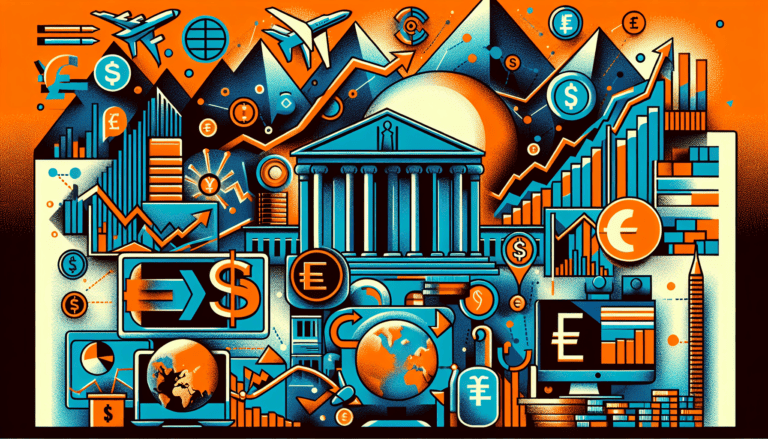A Beginners Journey: Exploring the Fundamentals of Forex Trading

Introduction to Forex Markets
The foreign exchange market, known as forex or FX, stands as the world’s largest financial market, offering numerous opportunities for investors. Here, one delves into the forex trading basics to understand what forex trading entails and the distinctive features that set this market apart.
What is Forex Trading?
Forex trading is the action of buying one currency while simultaneously selling another, aiming to profit from fluctuations in their relative values. This exchange happens in currency pairs, which are the foundation of forex trading activities. Traders strive to anticipate how exchange rates will shift and make trades accordingly to capitalize on these movements. As per IG, forex trading involves a deep understanding of market dynamics and the factors that influence currency values.
Key Features of Forex Markets
The forex market is unique due to its:
- Volume: It’s the most liquid market globally, with an average daily trading volume exceeding $6 trillion, as highlighted by DailyFX.
- Accessibility: Operating 24 hours a day during the business week, it allows traders to respond to market changes in real-time.
- Leverage: Most trading is possible due to leverage, which amplifies the trading capacity of investors, allowing them to open positions significantly larger than their account balances.
- Global Scope: As a decentralized marketplace, it spans across financial centers around the world, accommodating a diverse range of participants.
- Currency Pairs: It offers a variety of currency pairs, from majors with high liquidity and tight spreads to minors and exotics, each with their own risk profile and opportunities.
These features make forex markets particularly attractive to investors looking to engage in active trading and who desire a market that functions almost incessantly. For those new to forex, grasping the essentials, such as understanding currency pairs, and the market’s structure is crucial before diving into technical and fundamental analysis, risk management strategies, and exploring common forex trading strategies.
Currency Pairs Explained
When venturing into the foreign exchange market, understanding currency pairs is essential. These pairs are the foundation of forex trades and determine the exchange rates for currencies around the world.
Major vs Minor Pairs
Currency pairs are categorized into major, minor, and exotic pairs. Major pairs involve the US dollar (USD) and are the most widely traded. They make up approximately 75% of all forex trades and typically offer the tightest bid (buy) and ask (sell) spreads, which can lead to higher profitability for traders (CMC Markets). These include pairs like EUR/USD, USD/JPY, GBP/USD, and USD/CHF, which account for the majority of trading volume in the forex market (DailyFX). For more detailed information on the different types of currency pairs, including major, minor, and exotic, visit major, minor, and exotic currency pairs.
| Major Pairs | Description |
|---|---|
| EUR/USD | Euro and US Dollar |
| USD/JPY | US Dollar and Japanese Yen |
| GBP/USD | British Pound and US Dollar |
| USD/CHF | US Dollar and Swiss Franc |
Minor pairs, on the other hand, do not include the US dollar. They often involve major currencies against each other, such as EUR/GBP or AUD/JPY. These pairs may have wider spreads and lower liquidity compared to major pairs.
Reading Forex Quotes
A forex quote is composed of two currencies: the base currency and the quote currency. The base currency is the first currency in the pair, while the quote currency is the second. The quote shows how much of the quote currency is needed to purchase one unit of the base currency.
For example, if the EUR/USD pair is quoted at 1.2000, it means that 1 euro is equivalent to 1.20 US dollars. The first currency (EUR) is the base currency, and the second currency (USD) is the quote currency. For more on reading and understanding forex quotes, check out understanding currency pairs.
Understanding Pips and Lots
In forex trading, the term ‘pip’ stands for ‘percentage in point’ and represents the smallest price move that a currency pair can make. It is typically the last decimal place of a quote. The value of a pip varies based on the currency pair and the lot size of the trade.
Lot size refers to the number of currency units a trader is buying or selling. The standard lot size is 100,000 units of currency, but there are also mini, micro, and nano lot sizes that are 10,000, 1,000, and 100 units respectively.
| Lot Size | Units of Currency |
|---|---|
| Standard | 100,000 |
| Mini | 10,000 |
| Micro | 1,000 |
| Nano | 100 |
Traders often target currency pairs with higher pip values for short-term strategies, such as day trading, to maximize their potential gains (CMC Markets). Understanding how pips and lots work is crucial for managing trade sizes and potential profits or losses.
As a beginner in forex trading, grasping the basics of currency pairs, reading forex quotes, and comprehending pips and lots will provide a solid foundation for navigating the forex markets. It’s also important to combine this knowledge with technical analysis in forex, fundamental analysis in forex, and risk management in forex trading to develop comprehensive trading strategies.
Market Participants and Dynamics
The forex market, known for its vastness and liquidity, welcomes a diverse array of participants, each with their own motivations and strategies. Understanding who trades forex and why can provide beginners with crucial insights into the market’s mechanics and potential opportunities.
Who Trades Forex?
Forex trading attracts a wide range of participants, from individual retail traders to large institutions. According to Investopedia, the market sees an average daily trading volume exceeding $6.6 trillion, reflecting its massive appeal.
| Participant Type | Description |
|---|---|
| Individual Retail Traders | Private individuals trading for personal profit. |
| Banks and Financial Institutions | Major banks trade on behalf of clients and themselves. |
| Central Banks | National banks engage in forex to manage currency stability. |
| Investment Managers | Professionals overseeing large portfolios for clients. |
| Hedge Funds | Funds seeking profits from currency fluctuations. |
| Multinational Corporations | Businesses that need to hedge against currency risk due to operations in multiple countries. |
These participants contribute to the market’s dynamics, influencing currency exchange rates through their trades. In addition, they utilize various forex trading platforms and tools to execute their strategies effectively.
Why Trade Forex?
Individuals are drawn to forex trading for numerous reasons. The market’s unique features, such as its size, liquidity, and the ability to trade on leverage, make it an attractive arena for speculative trading.
- Accessibility: Forex markets operate 24 hours a day, five days a week, providing traders the flexibility to react to global events and economic indicators as they unfold (Investopedia).
- Leverage: Some brokers offer high leverage ratios, which means traders can control significant trade sizes with a relatively small amount of capital (Investopedia).
- Profit Potential in Both Directions: Traders can potentially profit from both rising and falling markets by going long or short on currency pairs. This flexibility is a defining characteristic of forex trading (DailyFX).
However, while forex trading can be profitable, it also involves significant risks, especially when using leverage. Beginners are encouraged to learn about risk management in forex trading and to start with smaller positions to get accustomed to the market’s volatility.
In conclusion, the forex market’s vast array of participants and the multiple motivations behind their trades create a dynamic environment ripe with opportunities. Beginners should approach this market with a robust foundation in forex trading basics, including an understanding of currency pairs, market analysis techniques such as technical and fundamental analysis, and strategies for mitigating risk. By doing so, they position themselves to navigate the forex market with greater confidence and insight.
Forex Trading Sessions
Global Trading Hours
The forex market is a global exchange open 24 hours a day, five days a week, providing ample opportunity for traders around the world to participate in trading activities. This round-the-clock operation is possible due to the decentralized nature of the market, which relies on a network of computers and not a single physical exchange that closes at a certain time. For individuals who are just beginning to learn the forex trading basics, it’s crucial to understand these hours and their implications on trading.
Forex Market Hours
| Financial Center | Open Time | Close Time |
|---|---|---|
| Sydney | 5:00 PM EST | 2:00 AM EST |
| Tokyo | 7:00 PM EST | 4:00 AM EST |
| London | 3:00 AM EST | 12:00 PM EST |
| New York | 8:00 AM EST | 5:00 PM EST |
(Source: IG, Investopedia)
Overlapping Market Sessions
The international scope of currency trading means that there are always traders across the globe who are making and meeting demands for a particular currency. The sessions in various financial centers overlap, ensuring continuous liquidity in the forex market. These overlaps correspond to times of higher trading activity and, often, greater volatility, which can be advantageous for traders.
Overlap Sessions
| Overlap | Time Period (EST) | Characteristics |
|---|---|---|
| Tokyo/London | 3:00 AM – 4:00 AM | Moderate levels of liquidity due to fewer participants |
| London/New York | 8:00 AM – 12:00 PM | High liquidity and volatility, popular for day traders |
(Source: Investopedia)
The London/New York session overlap is particularly noted for its high liquidity and volatility, making it a preferred trading window for many participants. Traders can capitalize on these conditions to potentially achieve better trade execution and more significant movements in currency pairs.
Understanding the intricacies of forex market hours and trading sessions is a fundamental aspect of forex trading basics. It allows traders to plan their trading schedule and strategies around these peak hours to maximize their chances of success in the forex market. Additionally, staying informed about global events and their impact on forex markets can provide traders with an edge, as these can significantly influence market conditions and currency valuations.
Fundamental Analysis in Forex
Fundamental analysis is a key component of forex trading, providing traders with insights into the factors that influence currency exchange rates. This analysis involves evaluating economic indicators and geopolitical events to predict market movements.
Economic Indicators
Economic indicators are statistics that provide information about the overall health of a country’s economy, and they can significantly impact the value of its currency. Common indicators include:
- Gross Domestic Product (GDP)
- Employment data
- Inflation rates
- Interest rate decisions
These indicators can signal the future direction of an economy and, in turn, influence forex trading strategies. Traders often monitor economic calendars to stay informed about upcoming data releases, as these events can lead to increased volatility in currency prices (Investopedia). For example, a higher-than-expected inflation rate may lead a country’s central bank to raise interest rates, which typically causes the currency to appreciate.
| Indicator | Potential Impact on Currency Value |
|---|---|
| High GDP Growth | Increase |
| High Employment | Increase |
| High Inflation | Mixed/Variable |
| Interest Rate Hike | Increase |
Understanding these indicators and their potential impact on the forex market can help traders make informed decisions and better manage risk in their trading activities. For further details on how economic indicators influence currency rates, visit the impact of economic indicators on forex.
Geopolitical Events
Geopolitical events encompass a wide range of occurrences, including but not limited to:
- Elections
- Political instability
- Wars and conflicts
- Natural disasters
These events can cause significant volatility in the forex market, as they often lead to uncertainty and unpredictability. For instance, the British pound experienced substantial fluctuations during the Brexit referendum in 2016, illustrating how political events can affect currency values (Investopedia).
Traders need to be aware of the potential for rapid changes in the forex market due to such events. They can do so by following international news and understanding the political and economic landscape of the countries whose currencies they trade. For more information on how global events can shake up the forex market, explore global events and their impact on forex markets.
Fundamental analysis is a vital skill for anyone engaged in forex trading. By keeping an eye on economic indicators and geopolitical events, traders can stay ahead of trends and changes in the market. To complement fundamental analysis, traders may also utilize technical analysis in forex to refine their trading strategies.
Technical Analysis for Forex
Technical analysis is a key component in forex trading, providing traders with tools and techniques to forecast future market movements based on historical price patterns and statistical trends. It encompasses a variety of methods, including the study of chart patterns and the use of technical indicators.
Chart Patterns
Chart patterns are formations created by the fluctuations in currency prices and can signal whether a current trend is likely to continue or reverse. Recognizing these patterns can be crucial for traders to make informed decisions.
- Head and Shoulders: This pattern indicates a reversal of a prior uptrend.
- Double Top and Double Bottom: These are reversal patterns signaling the end of a trend, either upward (top) or downward (bottom).
- Triangles: They can be symmetrical, ascending, or descending and typically suggest a continuation of the current trend.
- Flags and Pennants: These short-term continuation patterns indicate brief consolidations before the market resumes its previous trend.
For a deeper dive into how to identify and trade with these patterns, investors can refer to technical analysis in forex, which provides comprehensive guidance on interpreting various chart formations.
Technical Indicators
Technical indicators are mathematical calculations based on the price, volume, or open interest of a currency pair. These tools can help traders understand market sentiment and identify potential entry and exit points.
Here is a list of commonly used technical indicators in forex:
- Moving Averages: Indicate trend direction over a specified period.
- MACD (Moving Average Convergence Divergence): Shows the relationship between two moving averages.
- Bollinger Bands: Measure market volatility and overbought or oversold conditions.
- Stochastics: An oscillator that compares the closing price to the price range over a certain period.
- Relative Strength Index (RSI): Measures the magnitude of recent price changes to evaluate overbought or oversold conditions in the price of a currency pair.
Traders can use the RSI, for example, to gauge market momentum. When RSI levels are above 70%, the market is considered overbought, potentially signaling a forthcoming price decrease, while levels below 30% indicate oversold conditions, suggesting an opportunity for buying (CMC Markets).
To effectively utilize technical indicators, beginners should familiarize themselves with common forex trading strategies that employ these tools, such as the “bounce strategy” for trading off key historical levels or the “breakout strategy” for capturing new market trends (CMC Markets).
By mastering chart patterns and technical indicators, novice traders can enhance their ability to navigate the forex market with greater confidence. It’s also essential to integrate these tools with fundamental analysis in forex and robust risk management in forex trading to build a comprehensive trading approach.
Risk Management Strategies
In the realm of forex trading basics, understanding and implementing robust risk management strategies is essential for longevity and success. Traders must be aware of the tools at their disposal to protect their capital from significant market volatility.
Leverage and Its Risks
Leverage is a powerful tool in forex trading that allows individuals to control a large position with a relatively small amount of capital. It’s not uncommon for brokers to offer leverage ratios as high as 1000:1, which means with just $1 in an account, a trader can control a trade worth $1000 (Investopedia). While leverage can amplify profits, it also increases the potential for substantial losses, making it a double-edged sword.
| Leverage Ratio | Amount Controlled | Required Margin |
|---|---|---|
| 50:1 | $50,000 | $1,000 |
| 100:1 | $100,000 | $1,000 |
| 1000:1 | $1,000,000 | $1,000 |
Understanding the role of leverage in forex trading is critical. Traders must use leverage judiciously, keeping in line with their overall risk management strategy and not allowing the allure of quick profits to override the importance of capital preservation.
Using Stop-Loss Orders
One of the most effective risk management tools in a forex trader’s arsenal is the stop-loss order. This tool allows traders to set a predetermined level at which a trade will close automatically, thereby capping potential losses. By using stop-loss orders, traders can manage risk exposure and protect themselves from the downside, especially during times of unexpected market movements.
Stop-loss orders can be set at a fixed pip amount from the entry point or based on a percentage of the account balance. For example, a trader might set a stop-loss order 20 pips away from the entry point or limit the risk to 2% of the account balance on any single trade.
| Entry Point | Stop-Loss (Pips) | Risk Per Trade (%) | Potential Loss ($) |
|---|---|---|---|
| 1.2500 | 20 | 2% | $200 on a $10,000 account |
| 0.7500 | 15 | 1% | $100 on a $10,000 account |
| 1.5000 | 25 | 5% | $500 on a $10,000 account |
Utilizing stop-loss orders as part of a broader risk management in forex trading strategy can help traders maintain control over their trades and prevent emotions from leading to impulsive decisions. In conjunction with other strategies like position sizing and diversification, stop-loss orders contribute to a disciplined approach to the forex markets.
Traders who master the use of leverage and stop-loss orders are more equipped to navigate the forex markets effectively. These risk management tools, combined with technical and fundamental analysis, as well as a strong understanding of currency pairs, can lead to a more structured and potentially successful trading experience.





